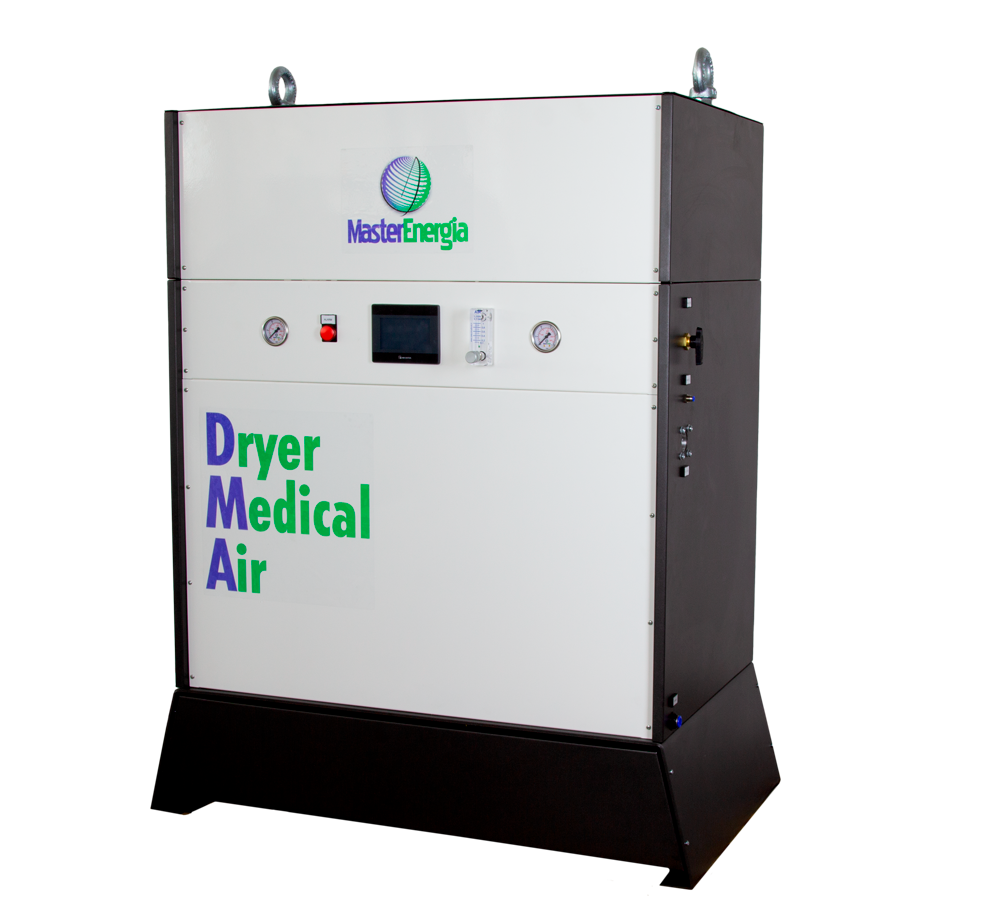AIR DRYING BY ADSORPTION
BREATHING AIR FOR MEDICAL APPLICATIONS
Breathing air is used to treat patients and it’s produced directly from compressed air. The European Pharmacopoeia defines it as “Breathing air for medical applications“. According to the European Pharmacopoeia (2000 edition), the range limits of pollutants for breathing air are:
- Carbon monoxide CO < 5 ppm to 2 ppm
- Carbon dioxide CO₂ < 500 ppm to 150 ppm
- Water vapour H₂O < 870*1) ppm to 15 ppm
- ” Sulphur dioxide SO₂ < 1 ppm to 0.1 ppm
- Nitrogen monoxide NO/NO₂ NO/NO₂ < 2 ppm to 1 ppm
- Oily particles < 0.1 mg/m³ to 0.003 mg/m³
- Oxygen concentration O₂ 20.4 – 21.4 % 20.8 – 21.1 %
- It should be odourless and tasteless
The main types of contaminants found in compressed air are solid (dust) and liquid (air-oil). Air and oil create emulsions and slimes which accumulate inside pipes and components. When reacting with emulsions, solid contaminants generate agglomerates which become increasingly larger and more compact.
MEDICAL AIR QUALITY
Compressed air treatment is crucial for medical applications, as compressed air is contaminated by the elements produced by compression. Moreover, contaminants can be found in the environment where the compressor is placed, as the compressor works on the air it suctions.
The compression process produces condense and, in case of lubricant-based compressors, oily particles. This is why condense is disposed of as toxic waste and must not be released in the sewage or in the soil without being treated with dedicated equipment. Any violation is punished according to the national Environmental Law. The importance of the treatment has led to the classification of the purity classes of compressed air in the ISO Standard 8573-1. The norm defines the methods and the tests necessary to study the contaminants found in compressed air. Solid contaminants are removed by means of mechanical or inertial air filters. Oil is subsequently removed using coalescing air filters. The filters have an increasingly accurate level of fil-tration, and depending on the desired air characteristics, even hydrocarbons and vapours can be re-moved. Sterile filters are used to filter breathing air, or the air to use in medical or food industries.
The DMA line of adsorption dryers by Master Energia produces high quality dry compressed air, com-pliant with the parameters established by the European Pharmacopoeia. Production processes are safe and energy efficient. They are designed to guarantee limited decreases in the internal pressure (lower than 0.2 bar/2.9 psi), while offering an efficient regeneration process.
MEDICAL AIR DRYER
The water vapor in the compressed air will be removed by dryer to the required level of Dryness ac-cording to the ISO Standard 8573-1. The Dryer works chemically and not by electricity. The electricity is required only for the operation of solenoid valves. The main material used in the Dryer cylinder is Active Alumina. Dryer will activate Alumina in its drying Columns to provide heatless, desiccant type air. In case of Electricity cut-off both columns will work to provide continuity of air. Dryer has two col-umns filled with Active Alumina which has a high absorption and discharge capability of water vapor from environment. The Drier works according to regeneration system. When one column is in drying process depending upon environment, 10-15 % of dry air is passed through regeneration column to dry the Active Alumina. The air flows through a series of molecular sieves, which trap air humidity. Ad-sorption dryers feature a regenerative filtering system. Compressed air flows upwards through the des-iccant material, which adsorbs humidity with a process starting from the bottom and moving upwards. The dry air coming from the desiccant tower expands at standard atmospheric pressure and is let through the saturated desiccant, causing the expulsion of the humidity adsorbed. After regeneration, the relief valve is closed and the tank is once again pressurised.
The energy consumption of a dryer mainly depends on the decreases in internal pressure and on the regeneration process.




